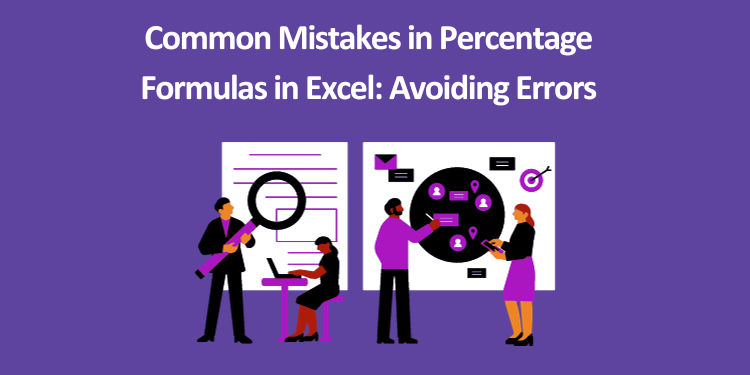Microsoft Excel is a powerful tool for performing various calculations, including percentage calculations. Whether you’re calculating percentages for financial analysis, tracking sales growth, or analyzing data trends, it’s essential to use the correct formulas and techniques to avoid errors. In this blog post, we will discuss some common mistakes in Percentage Formula in Excel and how to avoid them. We’ll also explore the importance of Microsoft Excel Training in mastering percentage calculations.
Table of Contents
- Importance of Microsoft Excel Training for Percentage Calculations
- Common Mistakes in Percentage Formulas
- How to Avoid These Mistakes
- Conclusion
Importance of Microsoft Excel Training for Percentage Calculations
Let’s stress the significance of Microsoft Excel training for understanding percentage computations before delving into the typical errors. Excel provides several formulae and functions for dealing with percentages, including SUM and AVERAGE, and numerous mathematical operators like *, /, and %. Comprehending the operation of these functions and their appropriate applications is essential for precise computations.
Employees who get Microsoft Excel training may acquire the skills and information necessary to utilise these features efficiently. Topics such as arranging cells for percentages, creating formulae for percentage computations, and resolving frequent mistakes may all be covered in training. Employees who have received the necessary training can compute percentages properly, which is necessary for them to make data-driven business choices.
Common Mistakes in Percentage Formulas
Incorrect Cell References: One common mistake is using incorrect cell references in percentage formulas. For instance, the formula “=A1/B1100” for % rise or “=B1/A1100” for percentage reduction should be used to get a percentage based on the two cells A1 and B1. Inaccurate results may arise from using the incorrect cell references or from skipping the multiplication by 100.
Incorrect Formatting: Mishandling the formatting of cells is another frequent error. Excel uses the cell format to determine what percentage a value is. Excel will read a cell’s value as normal if it is not structured as a percentage, which might result in inaccurate computations. Before using cells in percentage calculations, they must be formatted as percentages.
Misunderstanding of Percentage Increase vs. Decrease: Understanding the difference between percentage increase and decrease is crucial. The formula for percentage reduction is “(Old Value – New Value) / Old Value * 100,” while for percentage rise it is “(New Value – Old Value) / Old Value * 100.” Inaccurate results may arise from combining these formulae.
Order of Operations: Excel follows the order of operations (PEMDAS: Parentheses, Exponents, Multiplication and Division, Addition and Subtraction) when evaluating formulas. Inaccurate results may arise from not controlling the sequence of operations using brackets, particularly when mixing percentage computations with other mathematical operations.
How to Avoid These Mistakes
Double-Check Cell References: To ensure the cell references in percentage formulae are accurate, always double-check them. Cell references such as trace dependents and trace predecessors may be examined using Excel’s formula auditing features.
Format Cells Correctly: Format cells as percentages before using them in percentage formulas. To do this, select the cells, click the Number group on the Home tab and pick the % format.
Understand the Formulas: Take the time to understand the formulas for percentage increase and decrease and the order of operations in Excel. This comprehension will assist you in avoiding mistakes and guaranteeing precise computations.
Use Parentheses: When combining multiple operations in a formula, use parentheses to control the order of operations. By doing this, Excel will accurately analyse the formula and provide accurate results.
Conclusion
In conclusion, a thorough grasp of Excel’s formulae, functions, and best practices is necessary to become proficient in percentage computations. You may guarantee precise and dependable % calculations in your Excel spreadsheets by avoiding typical errors, including erroneous cell references, formatting issues, misinterpreting percentage growth vs. decrease, and ignoring the sequence of operations. Putting money into Microsoft Excel training for your staff may teach them the know-how to calculate percentages efficiently, eventually improving decision-making based on reliable facts.
